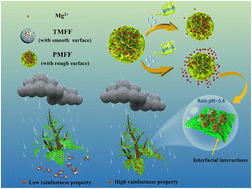In situ construction of a magnesium foliar fertilizer with pH-controlled release and high adhesion capacity†
Abstract
To solve the worldwide problems caused by magnesium deficiency in modern agriculture, a pompon-like magnesium foliar fertilizer (PMFF) was developed via an ammonia-assisted sacrificial nano silica template method. The ultra-thin curled nanosheets are distributed radially on the shell of the PMFF with an obvious hollow structure, which endows the PMFF with high adhesion capacity on the surface of plant leaves without being washed away by rainwater. Moreover, the release of nutrient element magnesium from the PMFF could be sensitively controlled by changing the pH of the solution. Unexpectedly, compared to the traditional magnesium foliar fertilizer (TMFF), the unique structure of the PMFF makes it have a good sustained-release ability, and its magnesium release during 48 h is 88.0 mg g−1. Benefiting from the rough morphology of the PMFF, the foliar adhesion efficiency, rainfastness capacity, and the fertilization utilization efficiency of magnesium were promoted by 10.4, 2.2, and 9.0 times in comparison with those of the TMFF (MgSO4 and Mg(NO3)2), respectively. This work provides a novel strategy to solve the problem of magnesium deficiency in crops worldwide and offers new opportunities and approaches for the application of nanotechnology in agriculture.



 Please wait while we load your content...
Please wait while we load your content...